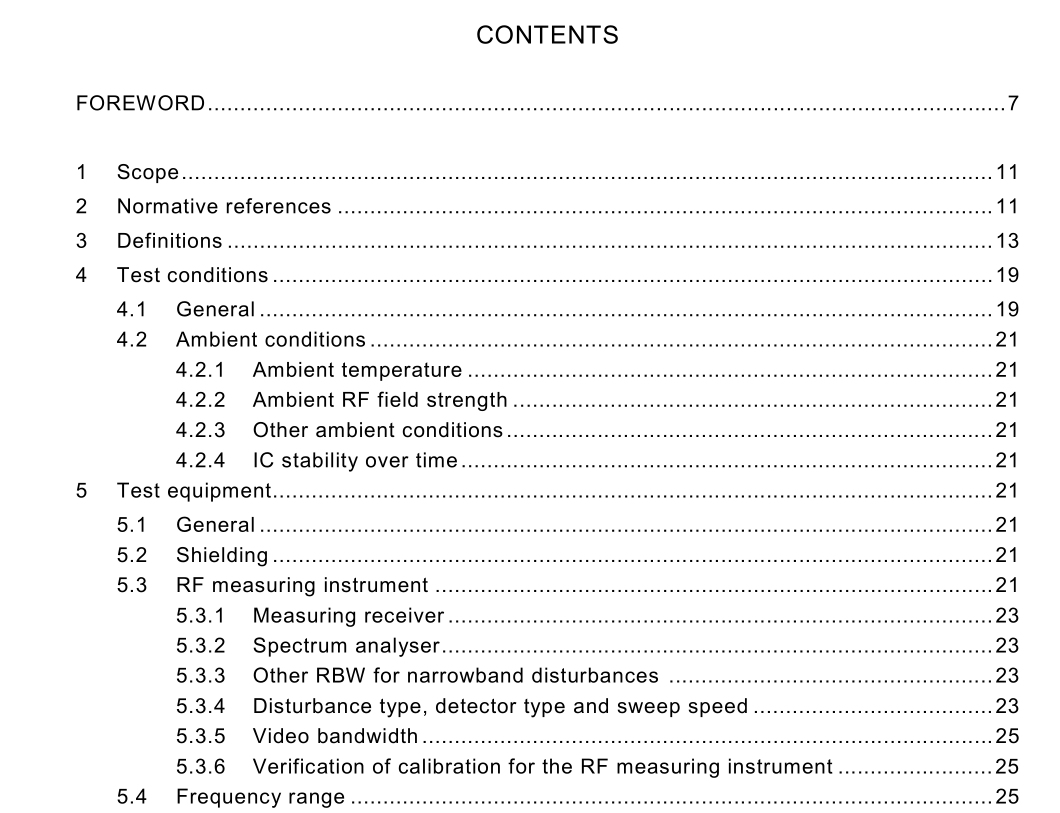IEC 61967-1 pdf download

IEC 61967-1 pdf download.Integrated circuits – Measurement of electromagnetic emissions, 150 kHz to 1 GHz
1 Scope
This part of IEC 61967 provides general information and definitions on measurement of conducted and radiated electromagnetic disturbances from integrated circuits. It also provides a description of measurement conditions, test equipment and set-up as well as the test procedures and content of the test reports. A test method comparison table is included as annex A to assist in selecting the appropriate measurement method(s). The object of this standard is to describe general conditions in order to establish a uniform testing environment and obtain a quantitative measure of RF disturbances from integrated circuits (IC). Critical parameters that are expected to influence the test results are described. Deviations from this standard are noted explicitly in the individual test report. The measure- ment results can be used for comparison or other purposes. Measurement of the voltage and current of conducted RF emissions or radiated RF disturbances, coming from an integrated circuit under controlled conditions, yields information about the potential for RF disturbances in an application of the integrated circuit.
3 Definitions
For the purpose of this part of IEC 61967, the following definitions, taken mostly from IEC 60050(161), apply. 3.1 artificial network AN agreed reference load impedance (simulated), presented to the EUT by networks (for example, extended power or communication lines) across which the RF disturbance voltage is measured and which isolates the apparatus from the power supply or loads in that frequency range [IEV 161-04-05, modified] 3.2 associated equipment transducers (for example, probes, networks and antennas) connected to a measuring receiver or test generator; also transducers (for example, probes, networks, and antennas) which are used in the signal or disturbance transmission path between an EUT and measuring equipment or a (test-) signal generator 3.3 auto sweep fastest calibrated sweep which a spectrum analyser will automatically select based on start frequency, stop frequency, resolution bandwidth and video bandwidth 3.4 broadband emission emission which has a bandwidth greater than that of a particular measuring apparatus or receiver [IEV 161-06-11, modified] 3.5 common mode voltage asymmetrical voltage mean of the phasor voltages appearing between each conductor and a specified reference, usually earth or frame [IEV 161-04-09] 3.6 common mode current in a cable having more than one conductor, including shields and screens, if any, the magnitude of the sum of the phasors representing the currents in each conductor [IEV 161-04-39] 3.7 conducted emissions transients and/or other disturbances observed on the external terminals of a device during its normal operation 3.8 continuous disturbance RF disturbance with a duration of more than 200 ms at the IF-output of a measuring receiver, which causes a deflection on the meter of a measuring receiver in quasi-peak detection mode which does not decrease immediately [IEV 161-02-11, modified] 3.9 device under test DUT device, equipment or system being evaluated NOTE As used in this standard, DUT refers to a semiconductor device being tested. 3.10 die shrink amount of shrink of the mask used to produce the integrated circuit (IC) expressed as a percentage or dimensions relative to the original artwork layout (drawn size) 3.11 differential mode current in a two-conductor cable, or for two particular conductors in a multi-conductor cable, half the magnitude of the difference of the phasors representing the currents in each conductor [IEV 161-04-38] 3.12 differential mode voltage voltage between any two of a specified set of active conductors [IEV 161-04-08] 3.13 discontinuous disturbance for counted clicks, disturbance with a duration of less than 200 ms at the IF-output of a measuring receiver, which causes a transient deflection on the meter of a measuring receiver in quasi-peak detection mode [IEV 161-02-28, modified] 3.14 electrically small PCB printed circuit board, whose dimension is smaller than λ/2, for example, 100 mm to 150 mm at 1 GHz 3.15 electromagnetic compatibility EMC ability of an equipment or system to function satisfactorily in its electromagnetic environment without introducing intolerable electromagnetic disturbances to anything in that environment [IEV 161-01-07]









